Press the (i) button at any time to switch between the computation screen and the help screen for a given task.
Use the device's screenshot key-sequence HOME-button (pressed first) + POWER-button
(tapped shortly) to save a screen-image to your personal folder.
Select desired task by tapping on the blue arrows or the text between them (selecting the text opens a dropdown menu).
Having selected a task you can press the EX button to set an example set of values into the displayed cells.
Use the (+/-) button on the last line to change the sign of a currently edited cell value (edited cells are highlighted with a larger font in white color).
The commonly used "a/b" button is provided for entering fractions and
the "Shift" button allows to switch between single-step and complete
solutions ( when pressing the [go] / [GO] button ).
Within the first 2 tasks the program computes cell values (after pressing the GO button) at certain positions within the table which cannot be edited.
Use the CL button to clear the table and enter new values at any desired position (if necessary).
Several tasks display intermediate results when you press the GO button , the final result appears after hitting the button 2 or more times.
support line : +49 171 182 4770
from Germany : (0171) 182 4770
(cellular phone) or the eMail address shipped with your iTunes / AppStore [TM] purchase.
main menu selector :
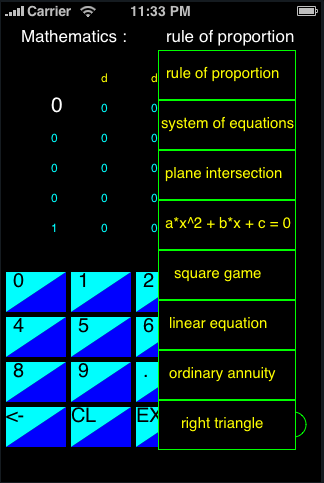
Tap the blue arrows (which are displayed after starting the application in the
upper area of the screen) to select the desired mathematical task step by step or
click on the area between the arrows (which shows the description of the actually selected task)
to open the main menu.
Selecting a task from it immediately closes the menu and switches to the new task.
list of the task screens with description :

Pressing at a computed value (11.667 in the example above)
shows in a blue frame the factor + operator that led to the selected value
from the previous value one line higher (in this case "7 / 0.6 = 11.667" )
See help text of the "Rule of Proportion" task (sometimes called
"Rule of Three" when only three lines are used) by pressing the
(i) button inside the program.
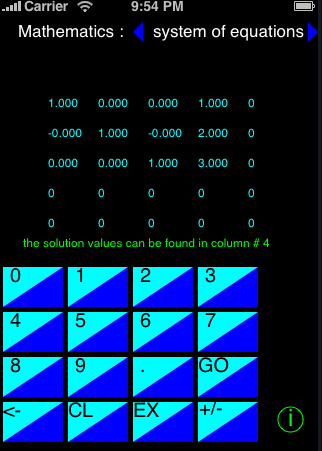
Enter the system of equations as matrix (2 lines * 3 columns , 3*4 or 4*5)
and press GO for each step of the solution.

Enter the factors a,b and c of a given equation
of type
f(x) = a*x2 + b*x + c = 0
or
f(x) = a * (x + b)2 + c = 0
Switching tabs automatically converts the factors a,b and c
(possible if parameter a is not equal to 0)
Press the [GO] button to compute possible intersections of f(x) with the x-axis
or press the blue "...draw graph" buttton in the middle of the screen to display
the function graph of f(x) :
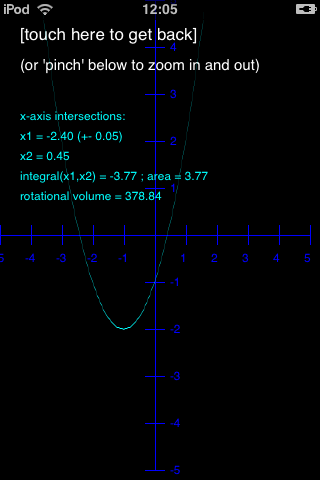 multi-graph :
multi-graph : 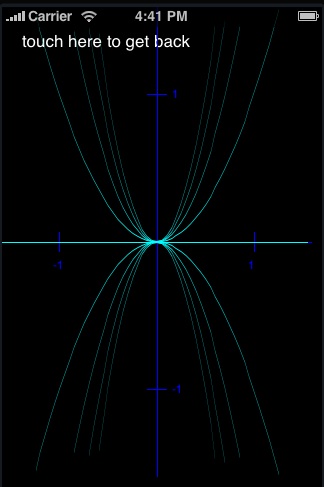
Pinching with 2 fingers - center should be the axis intersection (0|0) - allows to zoom in and out.
implemented in version 1.2:
Optional a set of fi(x) curves (where a selectable variable - a,b or c - goes through the values
i=-5 to 5 in steps of 1) can be displayed.
Selection of a variable for parametrization is done by moving the finger vertically over the
numeric field for the desired variable.
Closing the box that appears or selecting another variable deselects the first choice.

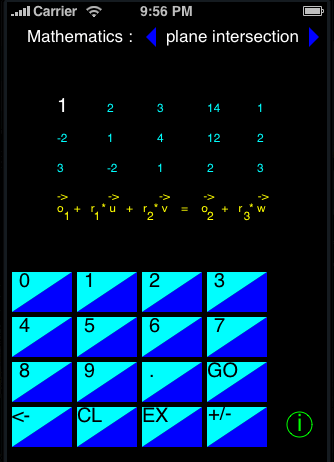
Enter the 3 components of each vector above the yellow printed symbol (o,u,v,o2,w)
and press GO
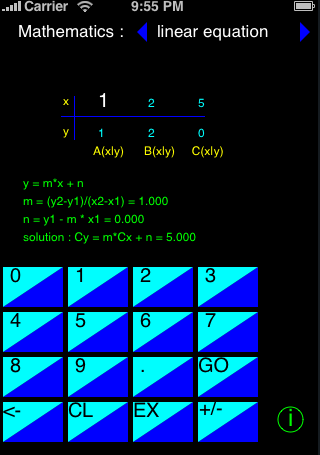
Enter values as requested on screen (several coordinate layouts and value combinations
can be set by pressing buttons in the mid-section of the screen) and press GO
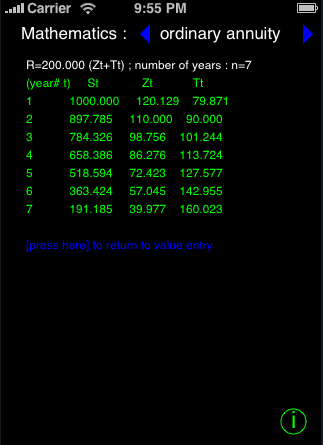
Entering the requested start values and pressing the GO button
displays the annuity table (if possible for the given values)
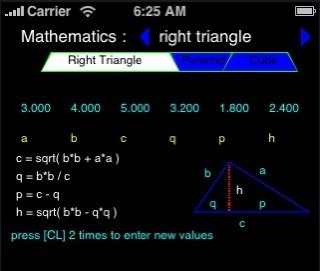 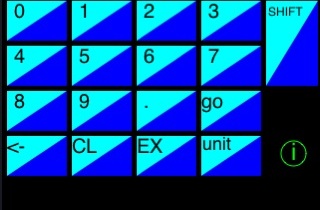 |
  |
  |
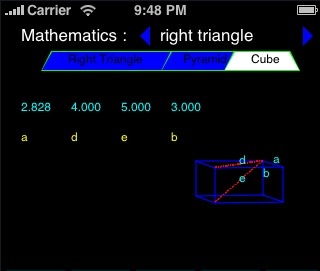 
|
Pyramid and cube have been implemented since version 1.2 ; Cuboid is new in version 1.3 ; unit conversion new in 1.5 (coming soon)
Clicking at a letter of the triangle , pyramid or cube image in the middle or the variable list in the upper part of the screen
selects entry of that value.
2 values are required to compute the complete right triangle, 2 suitably selected values are necessary for the pyramid,
1 for the cube and 2 for the cuboid ; select associated S.I. unit by pressing the [unit] key several times.
Computation is started with the GO button with automatic conversion of all units to one suitable common unit
and symbolic printout of the steps that are necessary for the solution.
(display of 'area','surface' and 'volume' in version 1.5)
note: display of "sqrt(...)" means "square root of ..." - e,g sqrt(2) = 1.414...
and display of "NaN" = "not a number" shows that no solution is possible for the given value(s).
The images of pyramid, cube and cuboid can be rotated with one finger.
The cube can be changed to a cuboid (with the parameters a,b,d and e)
using a 2 finger 'pinch' operation.
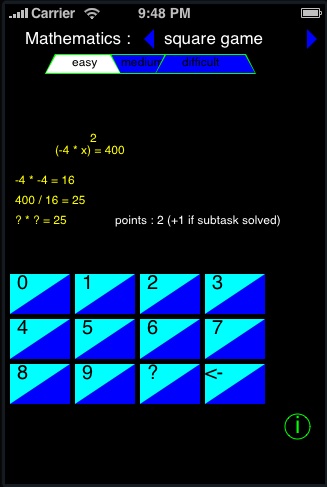
The square term game offers 3 difficulty levels that can be selected using the tabs.
Additional single-step subtask support is provided for the 'easy' difficulty level
(activated by swiping over the textlines in the mid-section on the left handside).
In subtask mode the solution of each subtask is asked separately
by the computer (e.g. '256 / 16 = ?' or '? * ? = 121' ).
Typing in digits replaces the questionmark with the user-solution.
As soon as the right solution is typed in, the next subtask is displayed
and 1 point is added to the score.
(press [?] button in the numeric field to skip a subtask and [<-] to delete last digit)

|
The application counts your steps (and the calories burned) based on the movement of the iPhone or iPod Touch when you carry it (wristwatch-style , at a belt , stabilized in a pocket or tied to your legs - latter position at your own risk of course). Acceleration values for the x- and y-axis of the device and the computed velocity values (actual, average and maximum velocity) are displayed on a timeline. The length of your steps can be set individually as well as the combination of axis-types (x,y or both axis) that are used to determine the number of steps. The value of burned calories (the program takes into consideration the speed of your movement when computing the value for each 5 seconds time interval) is displayed on the bottom of the main screen above the toolbar. |
 |
Values for calories and distance can be stored in a table together with the current date. Single day entries in that table can be combined to entries for individually chosen time-intervals (e.g. weeks,months or the duration of a holiday trip). |
set other weight values than 100 kg as well as another triggering value for the step-counter
(which is initially set to 0.4 g)
Press the (i) button on the right at any time to switch
between the main screen and the help screen with additional information.

|
 |
 |
 |
Das Programm zählt Ihre Schritte (und dabei verbrannte Kalorien) basierend auf der Bewegung des iPhone oder iPod Touch , wenn man das Gerät am Armgelenk, Gürtel, in der Tasche oder am Bein trägt - letztere Trageposition natürlich auf eigenes Risiko. Beschleunigungswrte für die x- und y-Achse des Geräts und die berechneten Geschwindigkeitswerte (aktuelle, Durchschnitts- und Maximalgeschwindigkeit) werden in einem Koordinatensystem graphisch dargestellt. Die Schrittlänge sowie die Kombination der Achsen (x,y oder beide Achsen), die für die Zählung der Schritte genutzt werden kann individuell eingestellt werden. Der Wert der verbrannten Kalorien (berechnet unter Beachtung der Bewegungsgeschwindigkeit) wird unten auf dem Hauptbildschirm (über der Werkzeugleiste) dargestellt. |
 |
Die Werte für Kalorien und zurückgelegte km können zusammen mit dem aktuellen Datum in einer Tabelle abgespeichert werden. Einträge für einzelne Tage in der Tabelle können zu Einträgen eines individuell bestimmbaren Zeitintervalls (z.B. Wochen, Monate oder die Dauer eines Urlaubsausfluges) zusammengefasst werden. |
Man kann das eigene Gewicht (voreingestellt ist 100 kg) sowie den Auslösewert der
Beschleunigung (voreingestellt ist 0.4g) über die Knöpfe der Werkzeugleiste festlegen.

|
 |
 |
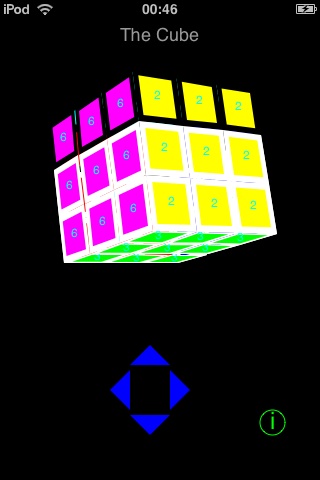
A 3*3*3 element cube puzzle with customizable graphical appearance and 4 cursor keys
to select a slice and quickly apply complete 90 degree rotations.
Optionally the slices can be rotated the classical way by selecting a slice with
the finger and dragging it the desired angle.
The cube itself is rotated by dragging outside.
Press the (i) button on the right at any time to switch
between the main screen and the help/options screen with help-text.
This help/options screen offers the ability to select the desired visual
appearance of the cube in the lower section and contains 2 buttons
(labelled "[new cube]" and "[shuffle cube]") in the mid-section which allow
the user to reset the cube or set a random state.
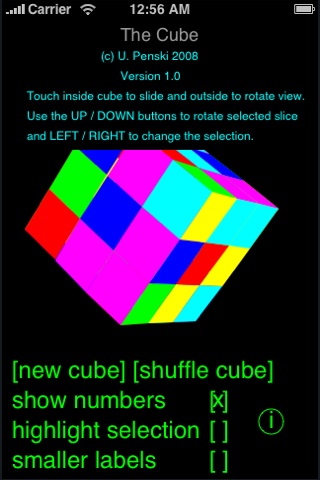
|
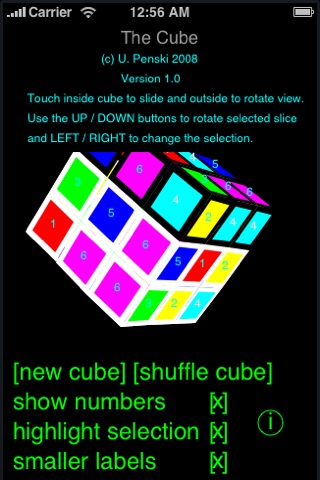 |
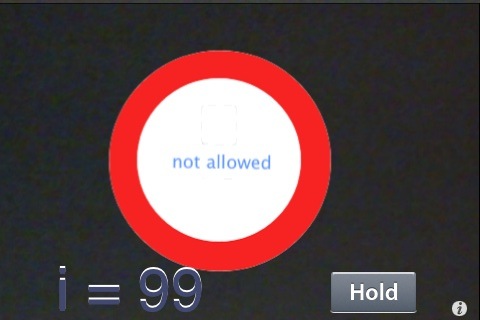
iWand is a (fake) metal detector for your next cops and robbers party.
A "not allowed" image appears gradually and a sound can be heard
when you reach the horizontal holding position of the iPhone or iPod touch
while "wanding" a person with it.
(With a bit of practice you can determine where the "contraband" seems to be hidden.)
The horizontal holding position can be calibrated and left-handed usage
(the home button shows to the holding hand) or right-handed usage
(home button shows away from hand) can be set in an option-screen.
An intensity-meter shows the detection strength of the hidden object as a value from i=0 to i=100 (percent).
Under usual conditions it is sufficient to connect earphones to the iPod Touch in order to hear the sound
in the vicinity of the device, but in a louder environment external speakers are recommended.
Use the [Hold]/[Release] button to freeze the image , so that it can be shown to the person that is wanded.
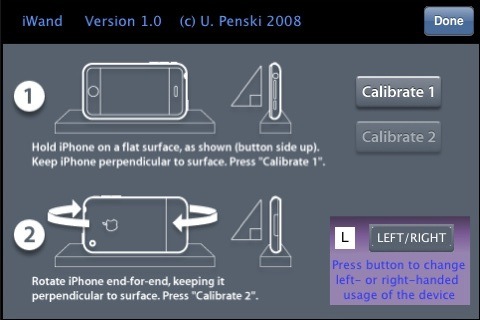
After pressing the (i) button you can calibrate the horizontal position of the built-in accelerometer to that edge of the iPhone or iPod touch
which shows the "i = ..." text and the [hold] and (i) buttons
(i.e. the lower edge in landscape position of the device when the "home-button" is positioned to the left).
Press the [LEFT/RIGHT] button to change left-handed or right-handed usage.
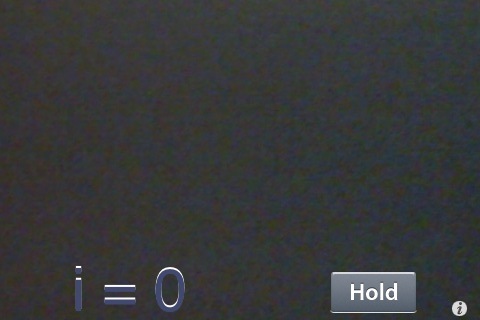
When the contraband is "out of range" (i.e. when you hold the device in an angle exceeding +40 or -40 degrees
relative to the calibrated horizontal position) , the screen shows a blurry image (similar to x-ray screens)
and displays a low intensity value (e.g. "i = 0").